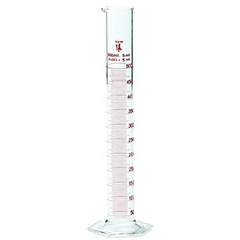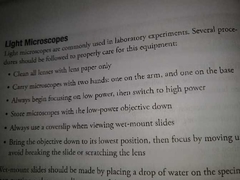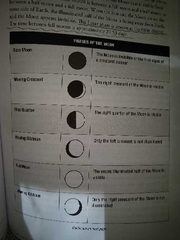![]()
![]()
![]()
Use LEFT and RIGHT arrow keys to navigate between flashcards;
Use UP and DOWN arrow keys to flip the card;
H to show hint;
A reads text to speech;
112 Cards in this Set
- Front
- Back
|
How should chemicals be stored |
in groups based on their reactivity with one another and in protective storage cabinets. All containers in the lab must be labeled |
|
|
What safety equipment is required by law in all science labs? |
Fire blanket, ground-fault circuit interrupters, emergency showers, signs designating room exits, emergency eyewash stations, eye protection, emergency exhaust fans, Master cut-off switches for gas electric and compressed air, fire extinguisher, storage cabinet for inflammable materials. |
|
|
What type of Life specimens can be dissected |
Lower-order life and invertebrates like jelly fish, tics, worms |
|

Graduated cylinders |
Use precise measurement. It should always be placed on a flat surface. measurement is read at the bottom of this curve call and meniscus -- lens shaped curve |
|
|
Care of light microscopes |

|
|
|
Most important aspect for diagnostic assessment for teachers |
Be clear about what they expect to do in their science teaching and newer qualities they hope to bring out in their students |
|
|
SCIENCE body of knowledge that is derived from... |
study, observation, and experimentation. |
|
|
Classifying is grouping items according to... |
Their similarities |
|
|
The control group is defined as the group in an experiment or study that ... |
does not receive treatment by the researchers and is then used as a benchmark to measure how the other tested subjects do. |
|
|
Scientific theory |
An explanation of a set of related observations based on a proven hypothesis |
|
|
Scientific law |
Usually last longer than a scientific theory and has more experimental data to support it |
|
|
Scientific method |
Process of thinking through possible solutions to a problem and testing each possibility to find the best solution |
|
|
Descriptive studies |
Address is the 5 W's. Who, what, when, where, and why. They also add additional so what? |
|
|
Science is a body of knowledge that involves... |
Involves study, observation, and experimentation. |
|
|
Examples of commonly used tools by biologist |
Computer Link probes, spreadsheets, and graphing calculators. |
|
|
What are the 4 physical properties of matter? |
Mass, weight, density, volume |
|
|
Two characteristics of matter |
Takes up space and has mass |
|
|
Mass is the amount of.... |
Amount of matter in an object. |
|
|
Weight |
Measure of the Earth's pull of gravity on an object |
|
|
Volume |
Amount of cubic space that an object occupies. |
|
|
DENSITY The mass of a substance contained per |
unit of volume |
|
|
Physical property |
can be observed without changing the identity of a substance. For example you can describe the color, Mass, shape, and volume of a book |
|
|
CHEMICAL PROPERTY is the ability of a substance to be change into a.... |
Ability of a substance to be change into new substances. baking powder goes through a chemical change or changes into carbon dioxide gas during the baking process |
|
|
Physical change or change of state |
Change that does not produce a new substance. For example the freezing and melting of water |
|
|
Chemical change or chemical reaction |
Any change of a substance into a new substance. For example burning material turns into smoke and is seltzer tablet fizzing to gas bubbles |
|
|
Conductor versus insulator |
conductor is a material that transfers the substance easily. An insulator is a material through which electrical charges move with difficulty if at all |
|
|
BOILING POINT is the temperature at which a liquid becomes... |
a gas |
|
|
Freezing point of water is |
32 degrees Fahrenheit or 0 degrees Celsius |
|
|
ENERGY is the ability to cause change in.... Hint "m" |
The ability to cause change in matter. Applying heat to Frozen liquid changes it from solid to liquid |
|
|
Condensation |
Change from gas-to-liquid |
|
|
MIXTURE- any combination of.... |
Any combination of two or more substances in which the substances keep their own properties |
|
|
Atom |
Nucleus surrounded by a cloud with moving electrons. Nucleus is the center of the atom. the positive particles inside the nucleus are called protons. Neutrons are another type of particle in the nucleus. |
|
|
Kinetic energy...is the energy of a... |
The energy of a moving object |
|
|
Potential energy |
The energy stored in matter due to its position relative to other objects. The energy that a ball has when perched at a top of a steep hill while it is about to roll down is an example of potential energy. |
|
|
Heat is energy that is .. |
Energy that is transferred between objects caused by differences in air temperatures |
|
|
Solar energy |
Radiation from the sun |
|
|
Hydroelectricity |
Electricity produced by moving water |
|
|
Geothermal energy |
Heat within the Earth. Geothermal power plants produce little if any pollution or environmental hazards |
|
|
THERMODYNAMICS is the study of... |
Study of energy & energy transfer. the branch of physical science that deals with the relations between heat and other forms of energy (such as mechanical, electrical, or chemical energy), and, by extension, of the relationships between all forms of energy.
|
|
|
Heat is the measure of.. and temperature is the measure of how... |
HEAT is the measure of energy. TEMPERATURE is a measure of how hot or cold a body is with respect to a standard object |
|
|
Name three types of temperature scales |
Celsius, Fahrenheit, Kelvin, |
|
|
Freezing and boiling points on Celsius and Fahrenheit temperature scales |
Celsius freezing point is 0 degrees and boiling point is 100°, Fahrenheit freezing point is 32° in boiling point is 212 degrees |
|
|
Heat capacity of an object |
Amount of heat energy it takes to raise the temperature of the object by 1° |
|
|
CALORIE... amount of energy it takes to... |
The amount of energy takes to raise one gram of water 1 degrees celcius |
|
|
Electroscope is a device used to indicate the existence of . |
a positive or negative charge |
|
|
GROUNDING is the removal of |
static electricity by conduction |
|
|
When electricity is passed through water H2O, it breaks the water down into hydrogen gas and oxygen gas |
... |
|
|
Newton's first law of motion |
Also called the law of inertia. is states that an object at rest will remain at rest and an object in motion will remain in motion unless acted upon by an external Force |
|
|
Newton's third law |
For every action there's an equal and opposite reaction |
|
|
OROGENY Natural mountain building due to |
volcanic action or some form of tectonic plate collision |
|
|
Physical composition of mountains |
Igneous, metamorphic, and sedimentary rocks. Most major mountain ranges are formed by the process of FOLDING and FAULTING |
|
|
Highest mountains in the world |
Himalayas |
|
|
FAULTS |
Fractures in the Earth's crust that have been created either by tension or compression forces transmitted through the crust |
|
|
Active volcano |
Volcano that is currently erupting or about to erupt |
|
|
Dormant volcano |
A volcano that is between eruptions but is showing signs of internal activity |
|
|
Extinct volcano |
The volcano no longer capable of erupting |
|
|
The curving belt of active faults and volcanoes is often called |
The Ring of fire |
|
|
When lava cools what type of rock is formed |
Igneous rock formation which can occur either above or below ground |
|
|
Ice age |
Time. In which glaciers advance over a large portion of a continent |
|
|
Rocks are aggregates of minerals. How are they classified |
They are classified by the differences in their chemical composition and the way they are formed. |
|
|
What are the three major subdivisions of Rock |
Igneous, sedimentary, and metamorphic. it is common for one type of rock to transform into another type which is known as the rock cycle |
|
|
Sedimentary rocks can reveal chronology and often contains fossils what are some examples of this type of rocks |
Chalk, limestone, sandstone, and shale |
|
|
Examples of metamorphic rock |
Slate and marble which are created when they are subjected to high temperatures and pressures |
|
|
What are soils composed of |
Particles of sand, clay, various minerals, tiny living organisms, and hummus, as well as the remains of plants and animals |
|
|
WHAT TWO MAJOR FORCES AFFECT WEATHERING |
Temperature and water |
|
|
Topography |
Flatness or healing hands of an area the arrangement of the natural and artificial physical features of an area."the topography of the island"a detailed description or representation on a map of the natural and artificial features of an area. |
|
|
How long does it take to form one inch of soil |
Several centuries. Soil of the Earth are millions of years old |
|
|
What are the three methods of heat transfer |
CONDUCTION, electron diffusion CONVECTION, movement of warm particles to cooler areas RADIATION, pheaa electromagnetic radiation. For example the warmth of an incandescent light bulb |
|
|
A sequence of changes in the ocean and atmospheric circulation across the Pacific ocean |
El nino |
|
|
Air currents |
Air masses moving toward or away from the Earth's surface |
|
|
Three major wind belts |
Trade winds, prevailing westerlies, polar easterlies. They circle earth like belts |
|
|
Monsoon |
noun: monsoonsa seasonal prevailing wind in the region of South and Southeast Asia, blowing from the southwest between May and September and bringing rain (the wet monsoon ), or from the northeast between October and April (the dry monsoon ). |
|
|
Relative humidity |
actual amount of water vapor in a certain volume of air compared to the maximum amount of water vapor the air can hold at a given temperature |
|
|
Reservoirs |
Man-made lake design for storing water |
|
|
Aquifers |
Underground region of porous material that contain water. The material can be porous rock or another substance such as sand or gravel |
|
|
Alternative Energy Source:. Biomass |
Plant and animal waste (decaying or decayed) can be burned to produce heat for steam turbine electric generators |
|
|
Fission vs. Fusion power |
Fission is a form of nuclear energy that uses potentially deadly radioactive elements, fusion mimics the power of the sun and is produced when small atomic nuclei fuse together to form new atoms |
|
|
The Earth orbits the sun in one year or 365 days |
... |
|
|
The moon orbits the earth every 27 days the changes in the appearance of the moon from the earth are known as lunar |
... |
|
|
Phases of the moon |

|
|
|
Tide |
Rise and fall of large bodies of water due to gravitational interaction between the Earth and the Moon |
|
|
Earth |
Earth is the third planet away from the sun in our solar system. Earth orbits the sun in a period of 365 days. The average distance between the Earth and the sun is 93 million miles |
|
|
Axis of the Earth |
Is tilted 23.5 degrees from the perpendicular. The tilt of the Earth's axis is known as the obliquity of the ecliptic and it's mainly responsible for the year |
|
|
Characteristics of the planets in the solar system |
Mercury is the closest planet to the sun, Venus has a slow rotation, Earth considered a water planet, Mars has many craters and active volcanoes, Jupiter is the largest planet, Saturn has rings of ice rock and dust particles circling it, Uranus is a third largest planet and is very gaseous, Neptune is also a gaseous |
|
|
COMETS are made up of masses of... |
Masses of Frozen gases, cosmic dust, and small rocky particles |
|
|
METEOROIDS are composed of... |
composed of particles of rock in the middle of various sizes. When it travels through the Earth's atmosphere friction causes surface to heat up and it begins to burn. I Bernie mineraloid falling through the Earth's atmosphere is called a media war also known as a shooting star |
|
|
USSR SPUTNIK |
Launched in October of 1957, was the first man-made object ever launched into space |
|
|
John Glenn |
The first American man to orbit the Earth |
|
|
Neil Armstrong and buzz Aldrin |
First man to reach the moon aboard Apollo 11 in 1969 |
|
|
Characteristic of living things |
Made of one or more cells that grow reproduce and die, living things respond to external stimuli, living things used in making energy |
|
|
Basic unit of all living things |
the CELL |
|
|
What is the purpose of cell division |
To provide growth and repair and to replenish or create sex cells for reproduction |
|
|
Mitosis versus meiosis |
Mitosis is the division of somatic cells or any other cells but the sex cells, meiosis is division of sex cells |
|
|
Animal cells differ from plant cells because they have ... |
...cell membranes |
|
|
TAXONOMY is the science of.... |
Carolus Linnaeus is considered the father of taxonomy which is the science of CLASSIFICATION |
|
|
Body size and shape are limited due to the force of gravity |
... |
|
|
AXIAL SKELETON |
Consists of the bones of the skull and vertebrae |
|
|
APPENDICULAR SKELETON consists of the bones of the... |
Consists of the bones of the legs, arms, tailbone, and shoulder girdle. |
|
|
TENDONS attach... |
Attach bones to muscles |
|
|
What is the function of the muscular system? |
Movement. And there are three types of muscle tissues: smooth, skeletal, cardiac, |
|
|
The NEURON is the basic unit of the nervous system |
... |
|
|
VOLUNTARY NERVOUS RESPONSES involve the brain |
... |
|
|
The DIAPHRAGM is a muscle below the.... |
Muscle below the lungs makes inhalation possible |
|
|
Function of the circulatory system |
to carry oxygenated blood and nutrients to all cells of the body and return carbon dioxide waste to be expelled from the lungs |
|
|
PLASMA |
60% of the blood is plasma, the liquid part period it also contains salts all the electrolytes, nutrients, and waste |
|
|
ERYTHROCYTES are also called |
Red blood cells and they contain hemoglobin which carries oxygen molecules |
|
|
LEUKOCYTES are also called |
White blood cells. They are are part of the body's immune system. They help the body fight infection and other diseases |
|
|
Excretory system |
To rid the body of nitrogenous waste via urine excretion |
|
|
ENDOCRINE SYSTEM manifactures and secretes.... |
chemical messenger system consisting of hormones, the group of glands of an organism that secrete those hormones directly into the circulatory system to regulate the function of distant target organs, and the feedback loops which modulate hormone release so that homeostasis is maintained. |
|
|
ARCHAE |
Single-celled prokaryotic life forms |
|
|
PROTIST |
And this kingdom organisms cannot be classified as fungi animals or plants |
|
|
Viruses are composed of what |
Genetic molecules DNA or RNA encased in the protein shell known as capsid |

